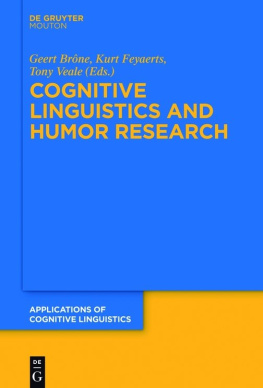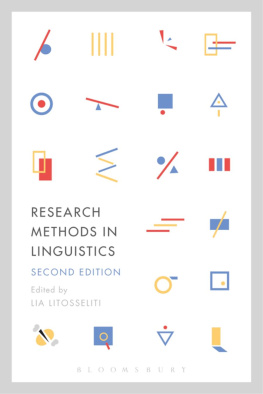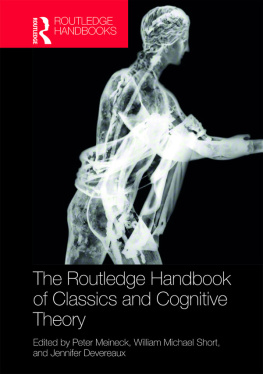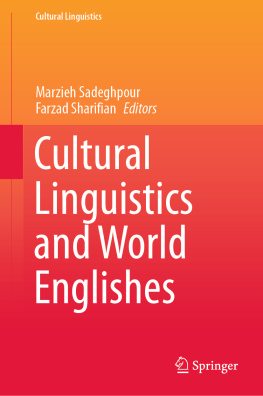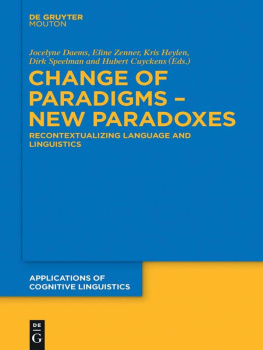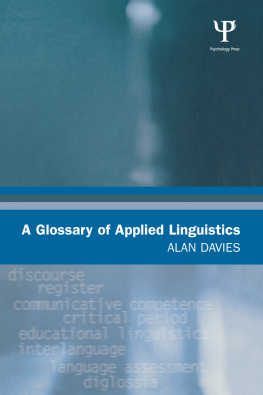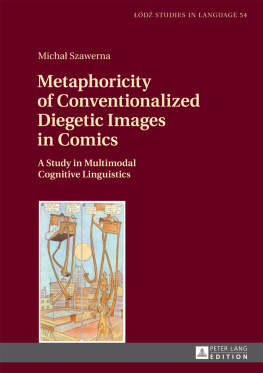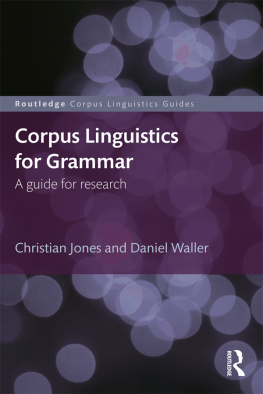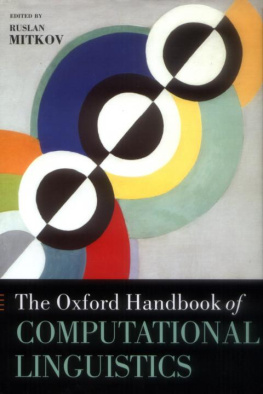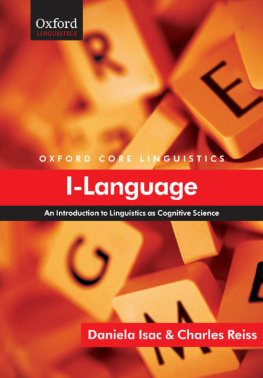Brône - Cognitive Linguistics and Humor Research.
Here you can read online Brône - Cognitive Linguistics and Humor Research. full text of the book (entire story) in english for free. Download pdf and epub, get meaning, cover and reviews about this ebook. City: Berlin/Boston, Germany, year: 2015, publisher: De Gruyter, genre: Home and family. Description of the work, (preface) as well as reviews are available. Best literature library LitArk.com created for fans of good reading and offers a wide selection of genres:
Romance novel
Science fiction
Adventure
Detective
Science
History
Home and family
Prose
Art
Politics
Computer
Non-fiction
Religion
Business
Children
Humor
Choose a favorite category and find really read worthwhile books. Enjoy immersion in the world of imagination, feel the emotions of the characters or learn something new for yourself, make an fascinating discovery.
- Book:Cognitive Linguistics and Humor Research.
- Author:
- Publisher:De Gruyter
- Genre:
- Year:2015
- City:Berlin/Boston, Germany
- Rating:5 / 5
- Favourites:Add to favourites
- Your mark:
- 100
- 1
- 2
- 3
- 4
- 5
Cognitive Linguistics and Humor Research.: summary, description and annotation
We offer to read an annotation, description, summary or preface (depends on what the author of the book "Cognitive Linguistics and Humor Research." wrote himself). If you haven't found the necessary information about the book — write in the comments, we will try to find it.
Brône: author's other books
Who wrote Cognitive Linguistics and Humor Research.? Find out the surname, the name of the author of the book and a list of all author's works by series.
Cognitive Linguistics and Humor Research. — read online for free the complete book (whole text) full work
Below is the text of the book, divided by pages. System saving the place of the last page read, allows you to conveniently read the book "Cognitive Linguistics and Humor Research." online for free, without having to search again every time where you left off. Put a bookmark, and you can go to the page where you finished reading at any time.
Font size:
Interval:
Bookmark:
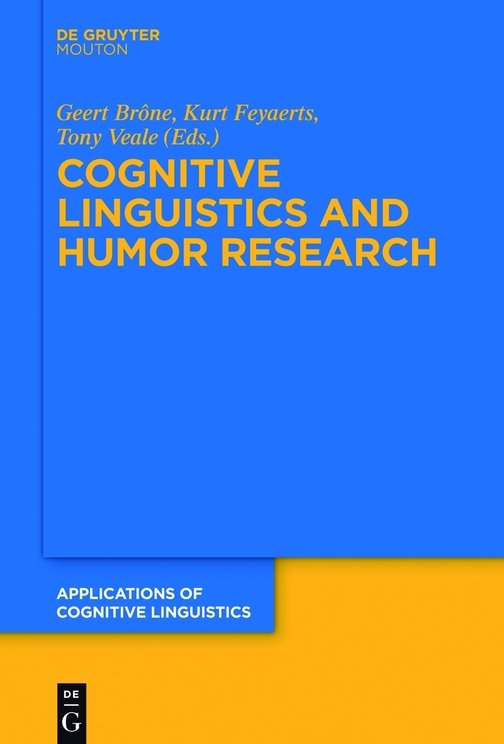
Tony Veale, Geert Brne and Kurt Feyaerts
contexts of its use. It allows us to invent words that give solid form to inchoate concepts or newly-birthed and still-unsettled ideas. As Goethe famously put it, words are most useful precisely when our ideas fail us. But language does more than paper over the cracks in our conceptual edifices. Humorous language actively seeks out these cracks, makes them evident to all, and proposes a means of filling the gaps that, if not always entirely practical, is nonetheless entertaining and thought-provoking (Fauconnier 1994; Coulson, this volume; Bergen and Binsted, this volume; Veale 2012; Veale, Feyaerts and Forceville et al. 2013). If language is the ultimate killer-app of the mind, it can often seem that humour as a powerful conceptual, communicative and social application is the killer-app of language, in the deepest and most subversive sense of killer (Giora 2003; Giora et al., this volume; Feyaerts and Oben 2014).
Language has a unifying power, one that allows us to condense a complex swirl of feelings and ideas into a single, highly evocative word or phrase. It allows us to construct a unified front around cognitive phenomena that are related but far from unified. This power, if unchecked by careful introspection and empirical analysis, can make essentialists of us all. Simplicity comes from having a single convenient word for a complex of related ideas, but simplicity also promotes over-simplification. As the philosopher Ludwig Wittgenstein put it, we are too often bewitched by language, beguiled into thinking that a certain concept such as KNOWLEDGE is simple and uniform and uncomplicated because language has furnished us with a single, simple word like know. Because we know how to use a word like know, we tell ourselves that we must also know how to understand the underlying concept of KNOWLEDGE. Much the same dilemma presents itself when we aim to study humour from a linguistic, cognitive or computational perspective. The ease with which we use words like humour or wit or joke beguiles us into viewing HUMOUR as an essentially uniform concept: though it may take on diverse forms in language, we are bewitched into thinking that there is a single coherent deep-structure that gives rise to them all. But this need not be the case: just as Wittgenstein and a generation of cognitive psychologists after him (e.g. Rosch 1978) have shown, we frequently use words like game or fake that give an unearned impression of simplicity to complex ideas that lack both sharp boundaries and an essentialist, easy-to-define core. As cognitively-minded researchers of HUMOUR, we must admit the same complexity in the study of whatever it is that the word humour denotes.
In this regard, the field of Cognitive Linguistics (CL) is ideally positioned to support the study of humour in language (see Brne, Feyaerts and Veale 2006; Brne 2008, 2010, 2012; Feyaerts 2013 for similar arguments). CL acknowledges that, as the killer-app of the mind, language can leverage many diverse aspects of human cognition to explore, shape and communicate our feelings, beliefs and ideas. Likewise, there is no crevice in language into which humour cannot force a wedge. Our jokes and witticisms can exploit the highest structural levels of language, from discourse and genre conventions to narrative forms, down through sentence structures, word-order conventions, agreement constraints, all the way down to morphology, spelling, pronunciation and stress patterns (cf. Attardo 1994, 2001; Ritchie 2004; Raskin 2008; Aarons 2011; Ruiz Gurillo and Alvarado 2013; Dynel 2013; Antonopoulou, Nikiforidou and Tsakona, this volume). There is no automatic process in language that, with sufficient cleverness, humour cannot force us to de-automatize. Humour can wrest control back from the most autonomous of linguistic processes, and force these processes to bring arbitrary aspects of world knowledge or the vagaries of a specific context to bear on their otherwise scripted behaviours. All humour is subversive, and linguistic humour subverts utterly the idea that any part of our linguistic apparatus has any real autonomy (Giora 2003; Giora et al. 2004, this volume).
The wide-ranging CL perspective is much-needed for the study of humorous language, as the need to appear sober and scientific in the study of what many consider to be a frivolous subject has driven many young researchers into the arms of the two least attractive aspects of the scientific enterprise: essentialism and reductionism. All too often, interesting theories on humour are reduced to the closest thing they have to an essentialist core, to yield a snappy label or phrase that fails to accommodate many of the interesting nuances that the underlying theories have to offer. It is as though a humour theory can gain no traction if it cannot be reduced to a pithy two-word oxymoron, whether incongruity resolution, appropriate incongruity, relevant inappropriateness, benign violation, mutual vulnerability, or any other pairing of opposites one cares to mention. These are convenient labels to be sure, and convey some flavor of the theories they attach too, but they can also do more harm than good for the study of humour. Humour theorists would do well to distance themselves from these labels. Victor Raskin, for instance, has always shown a wily reluctance to accept the label of incongruity resolution for the theory Semantic Script Theory of Humour (SSTH, Raskin 1985) and for its evolution into the General Theory of Verbal Humour (GTVH, Attardo and Raskin 1991; Attardo 1994, 2001). This reluctance seems odd when one considers that both the SSTH and GTVH give a key role to incongruity resolution, but this reluctance seems more sensible than odd when one considers that their creators consider these theories to offer much more than just incongruity resolution.
By providing a broad foundation of cognitive mechanisms into which one can anchor a study of humour, CL offers a way out of the essentialist trap. Humorous language need not hinge on a single cognitive mechanism, but can avail of them all. Ideas like incongruity resolution, appropriate incongruity, relevant inappropriateness and benign violation are all still useful in a CL account of humour, but they no longer have to serve as enigmatic ciphers for an otherwise ineffable quality or poorly-understood process. Instead, they can serve as convenient short-hands for the complex of interactions between cognitive mechanisms that ultimately give them their meanings. This is the true meaning of Goethes maxim about words and ideas: words and labels are IOUs when we are temporarily out of cash, or scaffoldings for conceptual buildings that are yet to be completed. Just as Wittgenstein described philosophy as a ladder that one kicks away when one reaches the understanding at the top, our convenient labels in humour research are designed to be cashed out, to be replaced by real cognitive understanding. The papers that comprise this volume each show researchers at different levels on their individual ladders. None is anywhere near reaching the top and kicking away either their ladders or their convenient labels, but each uses CL to climb their ladder, rung by rung. We ask you to judge for yourselves the progress they are making toward their goal, and the relative merits of the different ladders.
Given the focus of this volume on the application of concepts and tools from the broad field of CL, including classical notions such as metaphors, frames, mental spaces, conceptual integration, conceptual salience and grammatical constructions, to a wide range of phenomena that can be subsumed under the category HUMOUR, we do not primarily aim at an extensive review of the literature in humour research (see e.g. Raskin 2008, Martin 2007 for excellent reviews of the literature, and Brne, Feyaerts and Veale (2006), Brne and Feyaerts (2004) and Brne (2010) for a critical review of the position of CL vis--vis linguistic humour theories). Rather, the volume is intended as a collection of papers that explore the explanatory potential of the cognitive mechanisms that have played a central role in the field of CL. In this sense, this collection aims to cater for a broad public, including cognitive linguists interested in the empirical elasticity and valorization potential of their conceptual apparatus, cognitive scientists interested in the phenomenon of humour as the playground for the fluid conceptual system and humour researchers seeking additional analytical tools.
Font size:
Interval:
Bookmark:
Similar books «Cognitive Linguistics and Humor Research.»
Look at similar books to Cognitive Linguistics and Humor Research.. We have selected literature similar in name and meaning in the hope of providing readers with more options to find new, interesting, not yet read works.
Discussion, reviews of the book Cognitive Linguistics and Humor Research. and just readers' own opinions. Leave your comments, write what you think about the work, its meaning or the main characters. Specify what exactly you liked and what you didn't like, and why you think so.

